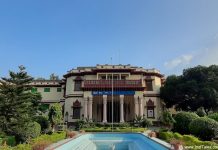I had a small halt in Kolkata. A friend who stays next to Jorasanko Thakurbari, which was the residence of Rabindra Nath Tagore, played the guide and took me around the huge house. A part of this now houses a university named after Gurudev and a part is dedicated to a museum depicting his life and times. It is known as Rabindra Bharti Museum. I could spend a couple of hours there and had a good insight into his life, a lot of which is not popularly known.
Jorasanko Thakurbari
Rabindranath Tagore
Everyone who has studied Indian history would know that Tagore came from the family of Zamindars or landlords. This particular house belonged to the large Tagore joint family. This is the house where Tagore was born, spent a large part of his life, and breathed his last. Apparently, he wanted to die in Shantiniketan, the university that he had set up a few hundred km away from Kolkata. But he was brought back to this house during his last days as the required treatment was not available in Shantiniketan.
Family House of Tagore
There are quite a few things that catch your eye in the house. The house is obviously huge. You can see it was meant to house the large family and its support staff. There is a dedicated delivery room where all kids in the house used to take birth. There is a middle courtyard which is like a small auditorium, with stairs for the audience to sit and a small stage for the performers. This is my interpretation after watching that space, there was no one there to explain this. The room where Tagore lived and died has been preserved in the same way as he used to use it. You are not allowed to touch anything or take pictures.
Portraits
There are blown-up pictures from the various stages of his life. So are portraits of all the prominent members of the family and an extended family tree. There is Rabindra Sangeet playing melodiously as you walk around.
Rabindranath Tagore’s Paintings
But the most interesting part of this place is the paintings by Tagore, which are amazing. There are also some of the notebooks in which he used to write. My friend explained that he would write and then blacken out the words that he wanted to discard. And a lot of times that would emerge out as a painting. You get snippets of the mind of the painter and a few glimpses into the Bengal of those times.
Gallery of Japanese Art – Jorasanko Thakurbari
There is a huge gallery depicting Japanese art. Tagore visited Japan a lot of times and there were lots of Japanese artists who came to India and stayed in Tagore’s house for years together and painted there. This fact made me think of most of the successful leaders of that time, and they were all probably the first generation of global citizens. And that gave their thought process a broader horizon than the rest of the public. Even when I was reading a book recently by Satyajit Ray, I found that apart from his talent, his exposure to global trends in his trade and his global connections also had a big hand in his success. Using the corporate world language, these people were enabled to use the “best practices” from around the world.
Surroundings of the House
Now what you would not really appreciate is all the filth and dirt that surrounds the house. You have to cross several drains like lanes to reach the house. When I was coming out, it reminded me of my visit to ‘Stratford upon Avon’, which is Shakespeare’s village, and the way they have preserved it. They even have a Tagore statue inside his house. The way they maintain the whole town and make all the information available to the visitors is amazing. I wonder why we can not even keep the places of heritage value, at least clean. So that they are at least not repulsive to the visitors.
Biplob, thanks for being my guide to the Jorasanko Thakurbari, without you taking me around, it would not have made as much sense to me.













Anuradha:…..All your blogs are thought provoking
especially your statemnet “Just me…start a conversation and help me discover me…” .
Take care ed viswanathan
http://www.amiahindu.com
Hello Anuradha,
Find your bllog when I jus gave my name on google, since I was feeling bored.
Liked your writings…
caio.
Interesting points on poet’s houses.
A few years back there were calls to get more money “injected” into the upkeep of Robert Burns house here in Scotland. I can’t remember the outcome but the house is still there and still being visited.
In a way, I sort of object to places like this becoming landmarks – the only important things that poets ever do is write poems (if “important” is the right word) so why should people care about where they stayed?
But having said that, it *will* be beneficial to the local community and I can’t object to that. And I secretly want to visit some homes/towns of famous British poets… so call me a hypocrite :op
Hi Anuradha di,
Such a long time I followed you. Appreciate your work very much. Just finished your beautifully-written about Jorasanko Thakurbari. And what stunning photos!
Thanks
Ruma Dey Baidya